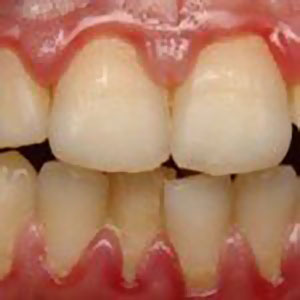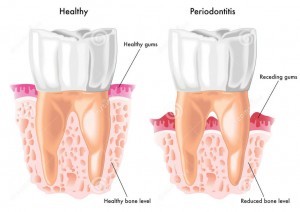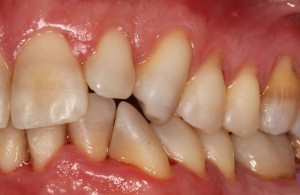Periodontal Gum Disease
What is Periodontal Disease (Gum Disease)
If your hands bled when you washed them, you would be concerned–yet, many people think it’s normal if their gums bleed when they brush or floss. Periodontal gum disease is one of the most common diseases of mankind. Don’t be surprised if you’re told you have periodontal disease—about 60% of American adults do! Gum disease is a bacterial infection of the gums, the supporting tissues of the teeth, and even the bone around the teeth.
Gum disease is the leading cause of tooth loss in the United States.

Common Types of Gum Disease
Although there are other less common types of gum disease often dismissed by the patient until irreversible damage is evident.
Gingivitis
Gingivitis is extremely common affecting about 2/3rd of adults in varying amounts. It is the inflammation of the superficial areas of the gums with the accumulation of dental plaque and the contributory factors to gum disease previously listed. Using proper brushing and flossing and the reduction of the contributing factors listed above, gingivitis can usually be controlled. The daily elimination of dental plaque, elimination of tobacco usage, and correction of faulty dental restorations are the most important controlling factors. Periodic dental cleaning visits on a regular basis can eliminate destructive dental calculus (calcified plaque).
Gingivitis–Red swollen Gums
Periodontitis & the Progression of Periodontal Disease
If left uncontrolled, gingivitis often leads into a much more destructive form of gum disease known as periodontitis. With this form of gum periodontal disease the infection progresses into the destruction of the supporting bone supporting the roots of the teeth. Intervention of knowledgeable dental personnel is absolutely necessary to prevent the disease from progressing into tooth loss.
Please review the adjoining diagram. We often tell patients to think of the tooth being similar to a fingernail—there is naturally a “cleft” like structure around the tooth. In dentistry we call it a “pocket.” Bacteria can collect in the deeper pocket area and the progressive destruction of the tooth support and bone loss can ensue.
With periodontitis daily home care is necessary along with the elimination of contributing factors and the removal of dental calculus (“deep cleaning” or scaling). Once a diagnosis of periodontitis is made intervention is needed and periodic dental hygiene visits are required every 3 month as the bacteria typically need 10 to 14 weeks to cause additional bone loss.

Bone Loss with Periodontitis
Signs of Gum Disease
Typical gum disease symptoms include swollen, red, and tender gums. Factors to note:
- Bleeding of the gums is no more normal than bleeding from any other part of your body! It is the body’s response to bacterial plaque—a bacterial infection of the gums.

Red Swollen Gums & Bone Loss
- Gum and periodontal disease are usually not painful and are often dismissed by the patient until the damage is extensive
- Gum disease is generally progressive and rarely improves unless the previously listed contributory factors are eliminated along with daily removal of bacterial plaque using proper home care, or dental treatment in the office.
- The appearance of “long teeth” and exposed roots us usually from improper brushing, clenching, or progressive gum disease. Also our section on recession.
- Teeth becoming loose (tooth mobility) is usually from bone loss around the roots of the teeth is considered to be a sign of more advanced disease.
- Teeth shifting positions is often from bone loss.
- Bad tastes or odors in the mouth can be a sign of gum infection.
- Painful chewing.
- Measurements of the groove (gums) around the teeth by the dentist or dental hygienist called dental pockets. Dental pockets normally are 1-3mm deep. If they become deeper, dental intervention will probably be needed to eliminate the bacteria that accumulates before additional destruction of the tooth support ensues.
Causes of Gum Disease
Although periodontal disease is common, it is usually preventable. The cause of periodontal issues is usually poor or faulty oral hygiene. For instance, many people may brush regularly but not use dental floss, allowing gum disease to start between the teeth. Bacterial deposits build on the teeth and gums forming a film known as dental plaque. The bacterial plaque over time causes gum inflammation—over time the effects of gum disease can lead to tooth loss.
Over time the dental plaque may absorb chemicals from the saliva and can calcify forming a material known as dental calculus that CANNOT be removed with patient tooth brushing. A trained dental
hygienist must carefully remove dental calculus using proper instruments.
There are many contributing factors to periodontal gum disease such as:
- Improper brushing or flossing. Our dental hygienist and assistants are experts in instructing patients on the best techniques to remove bacterial plaque.
- Dental decay harbors many of the same bacteria that cause gum disease.
- Faulty dental restorations such as rough, over-bulky, or leaking fillings may harbor bacteria that can’t be removed by the patient.
- Improper or old dental fillings or crowns may allow for food impaction between the teeth leading to decay or gum disease.
- Bad general health or untreated diseases such as diabetes. It should be noted (and discussed elsewhere) that there is a large correlation between gum disease and cardiac disease, strokes, diabetes, respiratory disease, and a large number of other systemic diseases.
- Corresponding to bad health is bad nutrition and stress that weaken the body’s immune system and eventually leading to gum disease.
- Tooth grinding or bruxism—causes the support of teeth to be over-stressed can greatly accelerate gum disease and tooth loss.
- Missing teeth-lead to remaining teeth being compromised due to over-stress on the support system and the teeth themselves.
- Genetics and family—Like it or not—members of the same family share many of the same bacteria! Also—some families genetically are more predisposed to gum disease.
- Smoking and tobacco use are highly correlated to progressive periodontal disease.
- Crowded teeth, dental partial dentures, and dental bridges may make effective removal of plaque difficult.
- Persons with diminished manual coordination such as elderly, dementia, mentally handicapped, and patients with physical injuries have issues with dexterity which makes it difficult to keep the gums healthy and the teeth clean.
Obviously—gum disease is a multi-faceted disease with many factors.—If you suspect gum disease consult with a knowledgeable dentist who can help diagnose and control the disease before it advances!
Also see our sections on:
Check Up
Make an Appointment Today!
Need a Smile Makeover, full mouth reconstruction or cosmetic procedure like veneers or crowns? Set up an appointment now without picking up the phone.
Hours
Monday: 11am – 8pm
Tuesday: 10am – 7pm
Wednesday: 8am – 4pm
Thursday: 7am – 3pm
Friday: Closed
Saturday: Closed
Sunday: Closed
